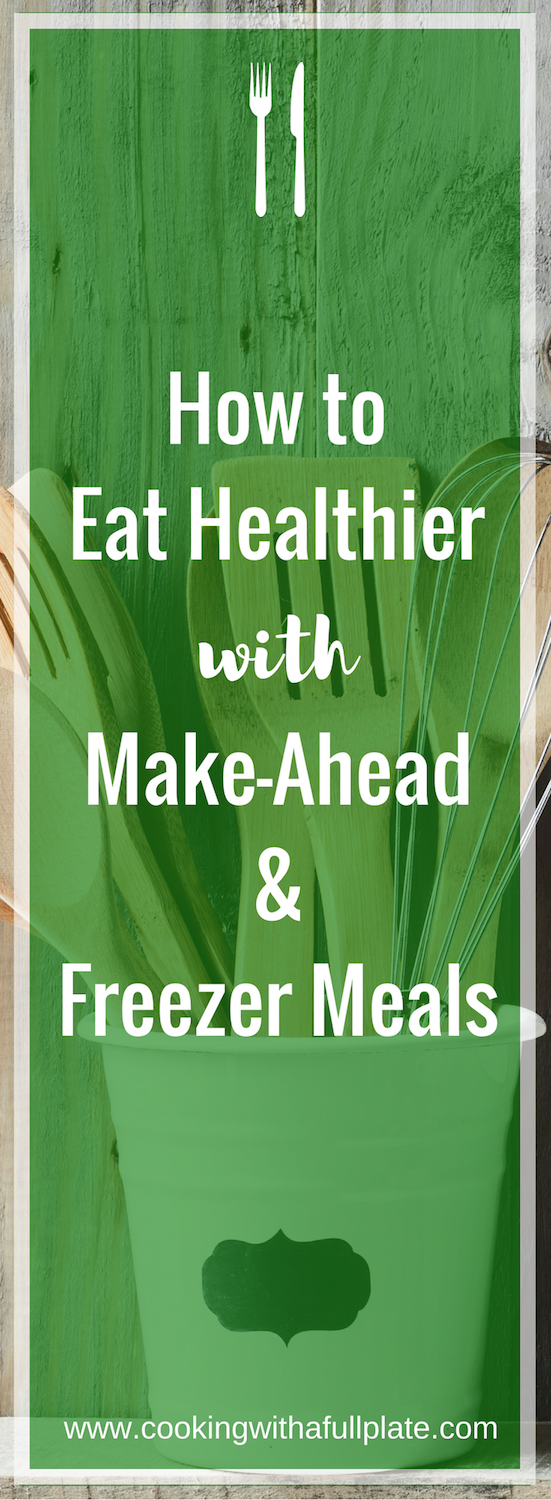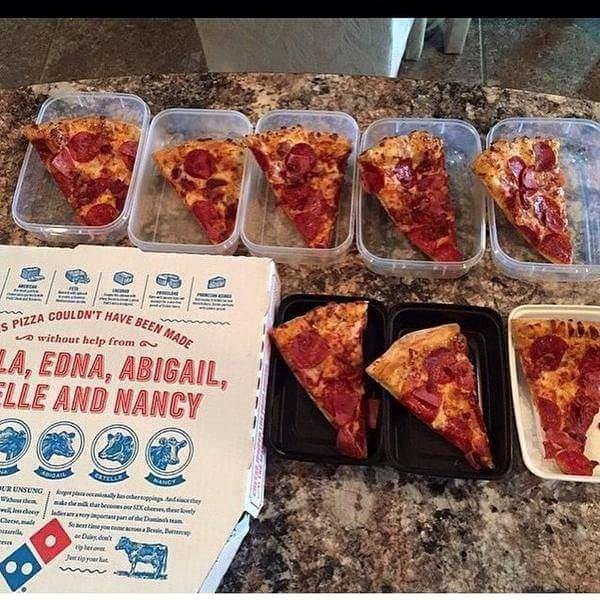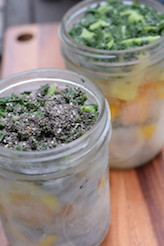School is starting. Work is busy. The kids want your attention. You can’t handle one more thing.
I hear these problems all the time when talking to parents and I struggle with them myself on the regular. When there’s too much to do cooking healthy food is one of the first things to fall to the back burner. It doesn’t take much to see that time is one of the biggest factors holding people back from eating at home more.
The thing is that planning, shopping for, and cooking food takes time. If you have to do all of that nightly before you want to eat it takes even longer. The single most effective way to cut down on your cooking and cleaning time is to consolidate your efforts. You can’t in fact make water boil or grill meat faster, but you can do all your shopping, chop many onions, and clean up the whole mess just one time if you use one of the make-ahead meal strategies outlined below.

Why Make-Ahead?
So if there are too many things to do already, why in the world would you take on making meals ahead of time?
Make-ahead meals are especially ideal for busy families because:
- Cooking in bulk reduces the common denominators of all meals like prep and cleanup
- Ensures that you have healthy food readily available at any time
- Takes away the need to “figure out what to make” which sometimes takes longer than the cooking itself
What Make-Ahead Cooking Style is Right for You?
First, you’ll need to decide whether you want to be a “Meal Prep Guru” or a “Make More Maven”. Choosing the style that works best for you is going to be key to making this a sustainable and enjoyable approach. See below for the details on what these things mean:
Meal Prep Guru
Meal prep is a concept that’s taken off in recent years, especially amongst fitness personalities. This may be one of my favorite fitness photos on the internet:

I’ve seen this one all over the internet, so I’m having trouble citing the original creator, but here’s where I found it. The comments are pretty funny if you feel like losing some time
Plenty of parent focused bloggers have also taken on this technique which focuses on:
- Preparing meals ahead of time, usually in one large prep day
- Packaging them up in desired serving sizes for use throughout the week
- Eating meals that were prepared ahead of time with little to no cooking or clean-up necessary on a daily basis
The pros:
- You get all of your cooking and cleaning done at once!
- No deciding throughout the week
The cons:
- You’ll need a good chunk of time for prep day (I’ve heard people say it takes anywhere between 1.5-5 hours depending)
- The cooking and clean-up on prep day can be a lot
- Less experienced cooks may take even longer because coordination and fast chopping are key
Here are some great ready-to-go resources for aspiring Meal Prep Gurus:
- Eating Clean Cooking Dirty is a weekly meal plan that helps you prep most of your food ahead so you can have healthy, quick meals any night.
- Once a Month Meals‘ name says it all. These folks can show you how to cook just once a month by utilizing some bulk cooking skills like prepping ahead, then freezing raw ingredients and easily cooking it up on the night you want to serve. They’re Meal Prep Gurus with a twist.
- Prep Dish is another weekly service that I’ve been following for some time. Alison also has a lot of great tips on meal prep in her newsletter.
- I just came across Momables in my search for this article, but she seems to have great stuff. Check out this how to post and her meal plan service.
Make More Maven
The characteristics of the “make more” approach are to use already appointed cooking times to make extra food (aka leftovers) that you can either store in the fridge or freezer for future meals. It’s really as simple as that.
The pros:
- There’s no additional “cooking session” because you’re just cooking more when you’d otherwise be making food
- Future clean-up is minimized because you’ll package up the leftovers to heat and eat
- No in the moment decisions to make as you’ll create a back stock of options, especially if you to the freezer route (hello burritos you made last month!)
- You can just cook extra of one part of the meal you’re making (e.g. browned meat for tacos) and freeze that so you have a neutral base for recipes in the future
The cons:
- Cooking and clean-up can take a little longer than single night cooking due to the extra volume of food
- Not all food keeps well, so you need to know how to decide what will (see below)
And here are some resources for the Make More Mavens. While there are less specific plans here than above, there are tons of good tidbits in these articles including recipes and what to freeze:
- Budget Bytes has a super thorough guide on How to Freeze Leftovers
- This article from the Kitchn is all about Recipes that Freeze Well
- Pioneer Woman, Ree, has some great tips and recipes for freezing food
- Smitten Kitchen has a great list of Freezer Friendly Recipes. Id’ think any of these could be made for dinner or breakfast and then leftovers packaged up and frozen for future use.
How to Successfully Prepare and Store Make-Ahead Meals
Choosing Make Ahead Recipes and How You’ll Store Them
The single most important decision you’ll make when taking the make-ahead route is in choosing the right recipe. The reason for this is that some recipes keep better than others and it would be a shame to be all kinds of time cooking ahead or making leftovers only to find out that they don’t taste as good the second time around.
In order to choose the right recipe, first you’ll need to decide how you’ll want to store your final product. As I see it, you have two options here (get ready, this is complex 😉 ):
- Refrigerator:
- Storage time is short, my general guideline is 3-5 days depending on the item
- Rarely impacts final textures and flavors of your food, so there is more flexibility in what you eat and save
- Faster to heat up when you’re ready to eat it
- Freezer:
- Storage time is long, generally up to 1 year depending on the item
- May impact final textures and flavors of food, so choosing the right recipes is key
- Remembering to defrost as needed will be key to enjoying the convenience of these meals
I know what you’re thinking: “That seemed to simple. Why is that even a decision that has to be made?”
The deal is that how you plan to store your final product is one of the key determining factors in what recipes will work and keep well. Here are some general guidelines:
- Fridge: baked goods, hearty salads (kale or cabbage), porridge, soups and stews, cooked meats, casseroles, really most things except time and temperature sensitive ones like cooked souffles or delicate fish
- Freezer: baked goods, porridge, soups and stews, cooked meats, casseroles
Freezing in particular can be tricky because of it’s potential impacts on both texture and flavor. Here are some things that I never freeze:
- Cream-based sauces as well as some dairy products like sour cream and yogurt don’t freeze well as they’re prone to separation
- Super garlicky items
- Thickened sauces
- Super-watery fruits and vegetables like lettuce, celery, and watermelon
- Cooked potatoes
Some Recipes to Get You Started
Ready to dive in and get cooking? In addition to the link you’ll find all throughout this article, here are some great tried and true Make-Ahead and Freezer Friendly recipes:
- Kid-friendly Crockpot Recipes from New Leaf Wellness look great because there’s no cooking ahead of time. You just package up the food, freeze, and throw it in the crockpot when you’re ready to cook it. There are tons of other free plans here.
- Buzzfeed Roundup of Freezer Friendly Meals has a lot of great recipe links and tips. I especially love the freezable oatmeal cups they shared.
- Smitten Kitchen‘s page of Freezer Friendly Meals has impeccable recipes (as always) but also some great clues into other things that might freeze well
Package them Up Correctly
After doing all that work to find the right recipes and cook them ahead of time, you want to give them the best chance of keeping well, right? This is especially important when it comes to freezer storage because you’re likely keeping them in there longer and the colder temperature will have more affect on improperly packaged food.
Mason jars are a great storage option! Especially for something like smoothie ingredients.
Here are some of the basics:
- Chill first: Putting warm food in the freezer is a recipe for iciness. Cool it down before packaging it up.
- Package tightly: Ziploc bags are a great tool to use here (and you don’t have to worry as much about the plastic if you cool the food down first) but Mason jars and storage containers can work well too. This is my favorite technique (check out the picture on top).
- Label clearly: I can’t count the number of times I’ve thought to myself “what the heck is this” while pulling out some icy concoction from the freezer. Learn from my mistakes. Label your packages clearly ideally with the item name, date it was made, and reheating instructions so the family can help themselves to tasty food.
- Store well: The items in the front of the freezer (and the door) get the most “abuse” from changing temperatures, which I learned from breastmilk storage. Make sure you keep you frozen foods nice and deep in the freezer without too much overcrowding so that they’ll stay fresh and no freezer burnt.
I know from talking to many parents that food safety and food storage are some of the main concerns in making food ahead of time.
